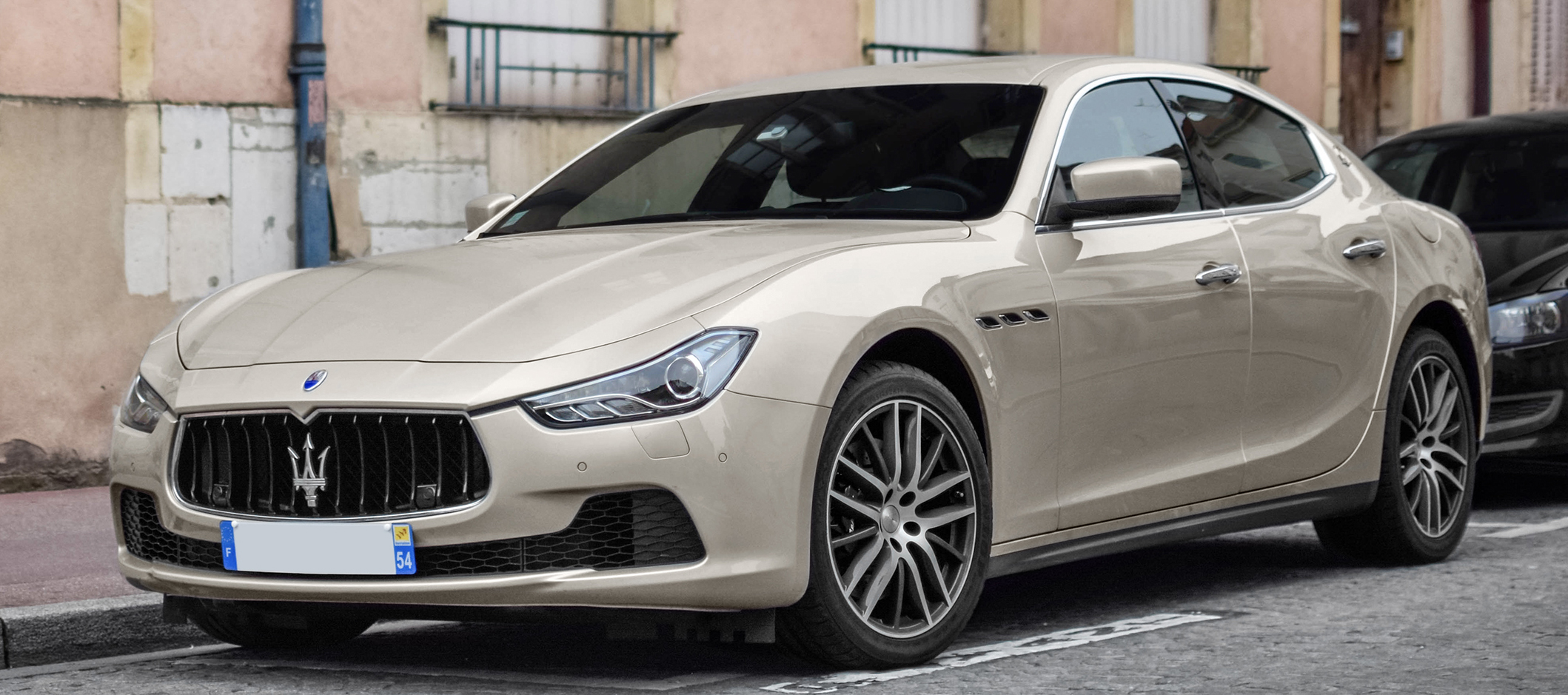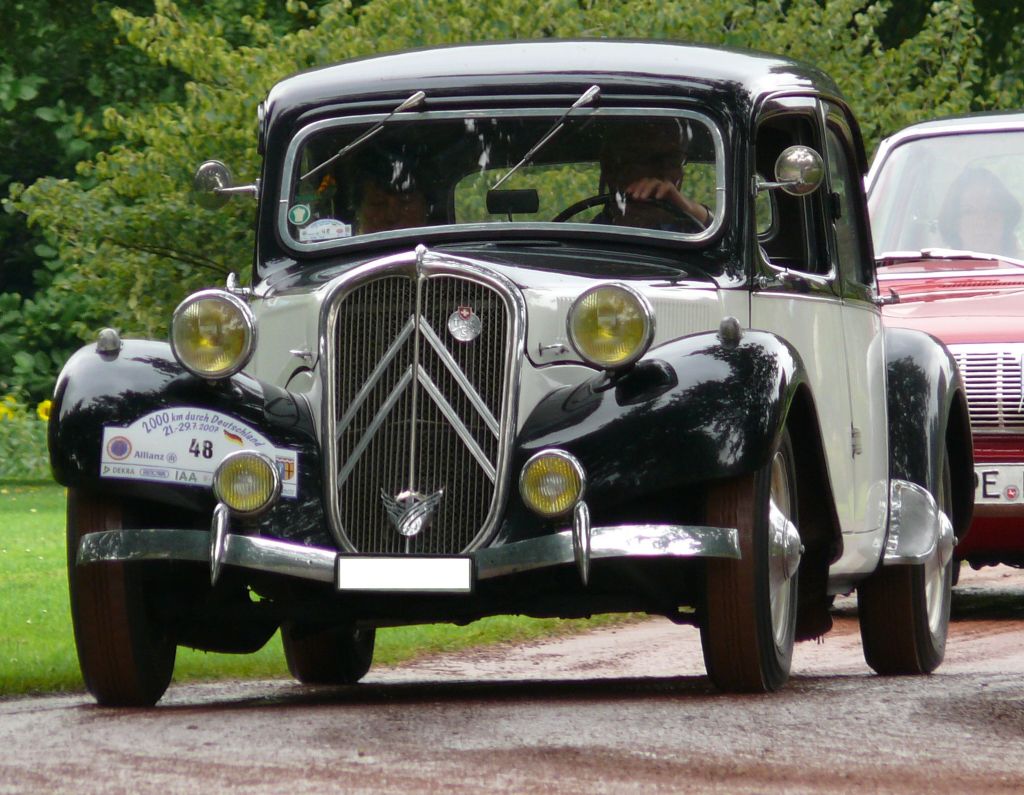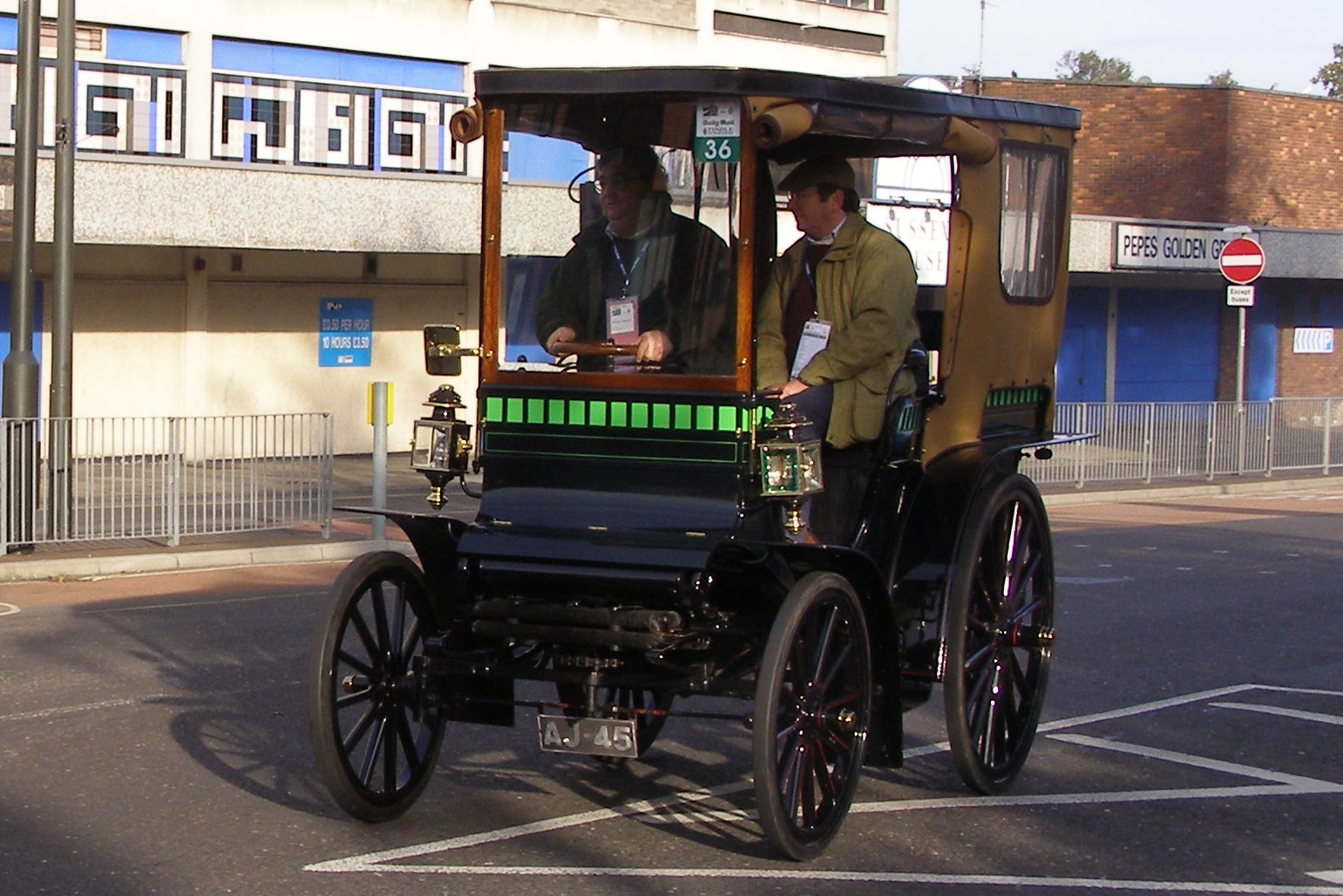|
Salmson S4
The Salmson S4 is a mid-size executive-level car introduced as the Salmson S4 C by Salmson, Société des Moteurs Salmson in Autumn 1932. It was the manufacturer's principal and often sole model for the next twenty years. The car's 1465 cc four-cylinder engine initially placed it in the 8CV Tax horsepower, car tax band, which would have placed it alongside lower-priced cars such as the Peugeot 301 and the Renault Monaquatre, but the Salmson's levels of technical sophistication and equipment, as well as its price, indicated that it was intended for a more aspirational clientele than these comparably sized cars. Within a few years the S4's four-cylinder engine had in any event increased in size to a point where the car sat in the 10CV Tax horsepower, car tax band, which moved the S4 up half a class as well as providing customers with a more convincing level of performance. The engines grew and the range widened. A 2.3-litre variant, the Salmson S4 E joined the less powerful ca ... [...More Info...] [...Related Items...] OR: [Wikipedia] [Google] [Baidu] |
Salmson
Salmson is a French engineering company. Initially a pump manufacturer, it turned to automobile and aeroplane manufacturing in the 20th century, returning to pump manufacturing in the 1960s, and re-expanded to a number of products and services in the late 20th and into the 21st century. It is headquartered in Chatou and has production facilities in Laval. It has subsidiaries in Argentina, Italy, Lebanon, Portugal, South Africa and Vietnam. History It was established by Émile Salmson (1858-1917) as Emile Salmson, Ing. as a workshop in Paris (1890), making steam-powered compressors and centrifugal pumps for railway and military purposes. Subsequently, joined by engineers George Canton and Georg Unné, it was renamed Emile Salmson & Cie, building petrol-powered lifts and motors (1896). The company became one of the first to make purpose-built aircraft engines, starting before World War I and continuing into World War II. After World War I the company looked around for other w ... [...More Info...] [...Related Items...] OR: [Wikipedia] [Google] [Baidu] |
Great Depression
The Great Depression (19291939) was an economic shock that impacted most countries across the world. It was a period of economic depression that became evident after a major fall in stock prices in the United States. The economic contagion began around September and led to the Wall Street stock market crash of October 24 (Black Thursday). It was the longest, deepest, and most widespread depression of the 20th century. Between 1929 and 1932, worldwide gross domestic product (GDP) fell by an estimated 15%. By comparison, worldwide GDP fell by less than 1% from 2008 to 2009 during the Great Recession. Some economies started to recover by the mid-1930s. However, in many countries, the negative effects of the Great Depression lasted until the beginning of World War II. Devastating effects were seen in both rich and poor countries with falling personal income, prices, tax revenues, and profits. International trade fell by more than 50%, unemployment in the U.S. rose to 23% and ... [...More Info...] [...Related Items...] OR: [Wikipedia] [Google] [Baidu] |
Executive Cars
Executive car is a British term for a large car which is equivalent to the European E-segment and American full-size classifications. Executive cars are larger than compact executive cars (and the non-luxury equivalent mid-size cars), and smaller than luxury saloons / full-size luxury sedans. The term has also been adopted by Euro NCAP, a European organization founded to test for car safety. Background The term was coined in the 1960s to describe cars targeted at successful professionals and middle-to-senior managers. It was used by businesses as an incentive for employees in senior roles and to exploit Britain and Europe's tax schemes as a company owned vehicle. Early executive cars typically offered engines with displacements of , compared with for an equivalent sized—but less luxurious—"large family car". Prior to the 1990s, executive cars were typically sedans, however in recent years they have also been produced in other body styles, such as estates (station wagons ... [...More Info...] [...Related Items...] OR: [Wikipedia] [Google] [Baidu] |
British Salmson
British Salmson was a British based manufacturer of cars, from 1934 to 1939. An offshoot of the French Salmson company, it was taken over by local management. After producing war supplies during World War II, it ceased car production, moved to Glasgow, Scotland, and produced printing machinery. Foundation In 1929, the French Salmson company started a British branch company, Moteurs Salmson in Raynes Park, London, as a radial aero engine maker for the British Empire market. Taken over by British sports car racer Howard Martineau and investors in 1930, they renamed it British Salmson Aero Engines Ltd and continued production under license. As aero engine sales proved slow, the company extended the license deal to include local production of cars from 1934. Production S4C The British S4C had the same twin-overhead-camshaft, 1471 cc, four-cylinder engine and chassis as its French parent, but the gearbox was updated to include synchromesh on the top two ratios. The coachwork ... [...More Info...] [...Related Items...] OR: [Wikipedia] [Google] [Baidu] |
Citroën Traction Avant
The Citroën Traction Avant () is the world’s first unibody front-wheel-drive car. A range of mostly 4-door saloons and executive cars, were made with four or six-cylinder engines, produced by the French manufacturer Citroën from 1934 to 1957. Approximately 760,000 units were produced. Whilst front-wheel drive and independent suspension had been established in the mass market by Auto Union and subsequently others some years before, the Traction Avant pioneered mass-production of a crash resistant, unitary, monocoque body. Additionally, the car was also an early adopter of rack and pinion steering. Although the car's name emphasized its front-wheel drive power delivery ("Traction Avant" literally means “front traction”), the car stood out at least as much by its much lower profile and stance – made possible by the absence of a separate chassis under the car's unitary body – sharply distinguishing it visually from its contemporaries. History The Traction Avant, F ... [...More Info...] [...Related Items...] OR: [Wikipedia] [Google] [Baidu] |
Inline-four Engine
A straight-four engine (also called an inline-four) is a four-cylinder piston engine where cylinders are arranged in a line along a common crankshaft. The vast majority of automotive four-cylinder engines use a straight-four layout (with the exceptions of the flat-four engines produced by Subaru and Porsche) and the layout is also very common in motorcycles and other machinery. Therefore the term "four-cylinder engine" is usually synonymous with straight-four engines. When a straight-four engine is installed at an inclined angle (instead of with the cylinders oriented vertically), it is sometimes called a slant-four. Between 2005 and 2008, the proportion of new vehicles sold in the United States with four-cylinder engines rose from 30% to 47%. By the 2020 model year, the share for light-duty vehicles had risen to 59%. Design A four-stroke straight-four engine always has a cylinder on its power stroke, unlike engines with fewer cylinders where there is no power stroke occu ... [...More Info...] [...Related Items...] OR: [Wikipedia] [Google] [Baidu] |
Popular Front (France)
The Popular Front (french: Front populaire) was an alliance of French left-wing movements, including the communist French Communist Party (PCF), the socialist French Section of the Workers' International (SFIO) and the progressive Radical-Socialist Republican Party, during the interwar period. Three months after the victory of the Spanish Popular Front, the Popular Front won the May 1936 legislative election, leading to the formation of a government first headed by SFIO leader Léon Blum and exclusively composed of republican and SFIO ministers. Blum's government implemented various social reforms. The workers' movement welcomed this electoral victory by launching a general strike in May–June 1936, resulting in the negotiation of the Matignon Agreements, one of the cornerstones of social rights in France. All employees were assured a two-week paid vacation, and the rights of unions were strengthened. The socialist movement's euphoria was apparent in SFIO member Marceau Pi ... [...More Info...] [...Related Items...] OR: [Wikipedia] [Google] [Baidu] |
Wall Street Crash Of 1929
The Wall Street Crash of 1929, also known as the Great Crash, was a major American stock market crash that occurred in the autumn of 1929. It started in September and ended late in October, when share prices on the New York Stock Exchange collapsed. It was the most devastating stock market crash in the history of the United States, when taking into consideration the full extent and duration of its aftereffects. The Great Crash is mostly associated with October 24, 1929, called ''Black Thursday'', the day of the largest sell-off of shares in U.S. history, and October 29, 1929, called ''Black Tuesday'', when investors traded some 16 million shares on the New York Stock Exchange in a single day. The crash, which followed the London Stock Exchange's crash of September, signaled the beginning of the Great Depression. Background The "Roaring Twenties", the decade following World War I that led to the crash, was a time of wealth and excess. Building on post-war optimism, rural Amer ... [...More Info...] [...Related Items...] OR: [Wikipedia] [Google] [Baidu] |
Delahaye
Delahaye was a family-owned automobile manufacturing company, founded by Émile Delahaye in 1894 in Tours, France. Manufacturing was moved to Paris following incorporation with two unrelated brothers-in-law as equal partners in 1898. The company built a low volume line of limited production luxury cars with coachbuilt bodies; trucks; utility and commercial vehicles; busses; and fire-trucks. Delahaye made a number of technical innovations in its early years; and, after establishing a racing department in 1932, the company came to particular prominence in France in the mid-to-late 1930s, with its Type 138, Type 135SC, and type 145 cars winning numerous races, and setting International records. The company faced setbacks due to the Second World War, and was taken over by amalgamation with arch competitor Hotchkiss in 1954. Both were taken over by the Brandt organization, within mere months, with automotive product manufacturing ended. History Formative years Engineer Émile Delah ... [...More Info...] [...Related Items...] OR: [Wikipedia] [Google] [Baidu] |
Peugeot 302
The Peugeot 302 is a mid-weight saloon introduced at the 1936 Paris Motor Show by Peugeot and listed, for just 18 months, until April 1938. Background The 302 was effectively a shortened version of the Peugeot 402 with a smaller engine. It was launched a year after the 402. Positioning the 302 The aerodynamic 402 was enthusiastically received by the market, but it was half a class larger than the Citroën Traction Avant which had in many ways rewritten the rule book when launched in 1934, and which during the later 1930s acquired a range of different engine sizes and wheelbase lengths. The 302 could compete more directly with the Citroën as a modest return to stability after the economic crisis of 1929 hinted at future growth in market demand for mid-sized saloons. Nevertheless, by the time the car was actually launched the country was in a state of industrial turmoil and heightened political uncertainty. A short life Peugeot had ended production of their popular 201 model i ... [...More Info...] [...Related Items...] OR: [Wikipedia] [Google] [Baidu] |
Ignition Magneto
An ignition magneto, or high-tension magneto, is a magneto that provides current for the ignition system of a spark-ignition engine, such as a petrol engine. It produces pulses of high voltage for the spark plugs. The older term ''tension'' means ''voltage''. The use of ignition magnetos is now confined mainly to engines where there is no other available electrical supply, for example in lawnmowers and chainsaws. It is also widely used in aviation piston engines even though an electrical supply is usually available. In this case, the magneto's self-powered operation is considered to offer increased reliability; in theory, the magneto should continue operation as long as the engine is turning. History Firing the gap of a spark plug, particularly in the combustion chamber of a high-compression engine, requires a greater voltage (or ''higher tension'') than can be achieved by a simple magneto. The ''high-tension magneto'' combines an alternating current magneto generator a ... [...More Info...] [...Related Items...] OR: [Wikipedia] [Google] [Baidu] |
1933 Salmson S4C Faux Cabriolet At Montlhéry
Events January * January 11 – Sir Charles Kingsford Smith makes the first commercial flight between Australia and New Zealand. * January 17 – The United States Congress votes in favour of Philippines independence, against the wishes of U.S. President Herbert Hoover. * January 28 – " Pakistan Declaration": Choudhry Rahmat Ali publishes (in Cambridge, UK) a pamphlet entitled ''Now or Never; Are We to Live or Perish Forever?'', in which he calls for the creation of a Muslim state in northwest India that he calls " Pakstan"; this influences the Pakistan Movement. * January 30 ** National Socialist German Workers Party leader Adolf Hitler is appointed Chancellor of Germany by President of Germany Paul von Hindenburg. ** Édouard Daladier forms a government in France in succession to Joseph Paul-Boncour. He is succeeded on October 26 by Albert Sarraut and on November 26 by Camille Chautemps. February * February 1 – Adolf Hitler gives his "Proclam ... [...More Info...] [...Related Items...] OR: [Wikipedia] [Google] [Baidu] |








.jpg)
